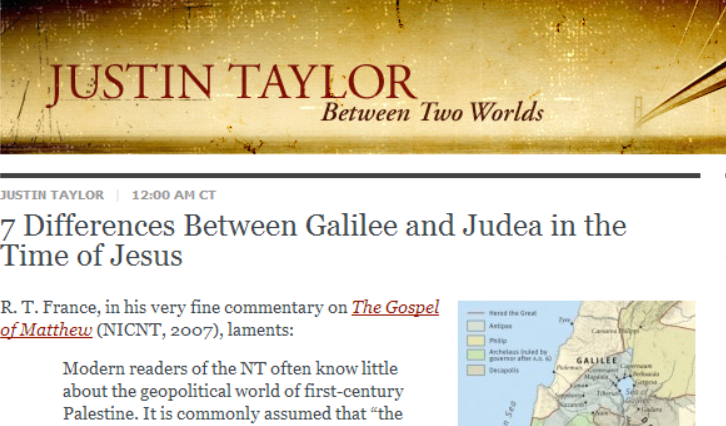Over a year ago Justin Taylor of the Gospel Coalition (not the Justin Taylor, SM of Hebrew University) posted a blog summarizing seven differences between Judea and the Galilee during the Time of Jesus. The summary was from R. T. France’s The Gospel of Matthew.[17] While I agree with France’s so-called lament that NT scholars know little about the world of “first-century Palestine,” we should be careful not to carry on long-standing myths about the world of 1st century Judaism that do not bear out in archaeological or historical sources.
While there were differences between Galilee and Judea these differences seem limited to geographical realities and particular interpretations regarding the commandments. We should not presume, however, that the ancient Jewish communities’ lack of monolithic (or unilateral) unity is equal to a stark separation in thought, language, and even race.[18] Unfortunately, if Taylor’s summary of France is correct, his list of differences between Galileans and Judeans does not take into account the full weight of archaeological and historical evidence. Much of this regarding the Galileans is the mistaken notion that in the days of Simon to Judah Aristobulus, the Maccabean kings repopulated the Lower Galilee on the western side of the lake with Itureans who were forcefully converted to Judaism. In that sense, the Jews of Galilee were distinctly different than their Judean counterparts. The Galileans Jews were thus uneducated, agrarian groups of commoners who were looked down upon by the educated and wealthy southerners. Thus, Jesus’ Galilee, and Jesus himself, was part of society that descended from forced converts who spoke differently and were lax concerning the observance of the law. At a minimum it separates Jesus (philosophically, religiously, and culturally) from the religious and cultural center of Jewish life in the 1st century. That minimum is too heavy a price to pay!
Premium Members and Friends of JP must be signed in to view this content.
If you are not a Premium Member or Friend, please consider registering. Prices start at $5/month if paid annually, with other options for monthly and quarterly and more: Sign Up For Premium
We should attribute any differences between Galileans and Judeans, especially what we have recorded in historical documents, primarily to issues of opposing halakhic opinions. Various halakhic opinions should not be understood, however, as a point of stark division in Judaism but rather a point of intra-Jewish discourse. The disagreements that Jesus often finds himself in are generally matters of Torah observance. To suggest that the aforementioned seven points stand is to misread the evidence that we know with the unnecessary consequence of tearing Jesus from his proper place in Jewish culture.
- [1] Mordechai Aviam, “The Hasmonean Dynasty’s Activities in the Galilee” in Jews, Pagans and Christians in the Galilee—35 Years of Archaeological Excavations and Surveys: Hellenistic to Byzantine Period (Rochester: University of Rochester Press, 2004), 41. ↩
- [2] See Aviam’s discussion of the Jewish and Gentile border in “Border between Jews and Gentiles in the Galilee” in Jews, Pagans, and Christians, 9-21. ↩
- [3] “Borders between Jews and Gentiles in the Galilee” in Jews, Pagans, and Christians, 17. ↩
- [4] “They are not Ritual Baths” BAR 26/4 (Jul/Aug, 2000). ↩
- [5] “They are Ritual Baths” BAR 28/2 (Mar/Apr, 2002). ↩
- [6] Mark Chancey and Eric Meyers, “How Jewish Was Sepphoris in the Time if Jesus” BAR 26/04 (July/Aug, 2000). ↩
- [7] “The Myth of a Gentile Galilee” The Bible and Interpretation (Feb, 2003). See also, idem, The Myth of a Gentile Galilee (SNTSM 118; Cambridge: Cambridge University Press, 2004). ↩
- [8] “Samaritans” Encyclopedia Judaica (vol. 17; New York: Thomas Gale, 2007), 718-737. ↩
- [9] Anson Rainey and Steven Notley, The Sacred Bridge: Carta’s Atlas of the Biblical World (Jerusalem: Carta, 2005), 362. ↩
- [10] See Shmuel Safrai, "Pilgrimage in the Time of Jesus"; also, idem, Pilgrimage in the Time of the Second Temple (Jerusalem, 1985 [Heb.]); Mordechai Aviam, "Reverence for Jerusalem and the Temple in Galilean Society," in Jesus and the Temple: Textual and Archaeological Explorations (Minneapolis: Fortress Press, 2014), 123-144. ↩
- [11] Aviam, “The Borders,” 13. These boundaries are based on Josephus’ description of when he comes to the Galilee to fortify certain cities and prepare for war with Rome. ↩
- [12] Marc Turnage, “The Linguistic Ethos of the Galilee,” The Language Envoronment in First Century Judea: Studies in the Synoptic Gospels vol. 2 (JCP 26; Leiden: Brill, 2014); cf. also Kutscher, A History of the Hebrew Language, 115-116. ↩
- [13] Lawrence Schiffman, “Was There a Galilean Halakhah?” in The Galilee in Antiquity (New York and Jerusalem: Jewish Theological Seminary, 1992), 144–45. ↩
- [14] Safrai, “The Jewish Cultural Nature of Galilee in the First Century” in The New Testament and Jewish-Christian Dialogue, Immanuel 24/25, 174–80; See the JP version. ↩
- [15] Turnage, “Linguistic Ethos,” 173. ↩
- [16] For the record it should be noted that the word Ἰουδαία (Judea) and its various forms appear sparingly in the Synoptic Gospels and not as some sort of foreign territory separated from the Galilee. ↩
- [17] R. T. France, The Gospel of Matthew(NICNT, Grand Rapids: Eerdmans, 2007). ↩
- [18] As you will see below “race” is a term used by France. It is an unfortunate term that I do not think best describes the differences between Galilee and the Judea. ↩



